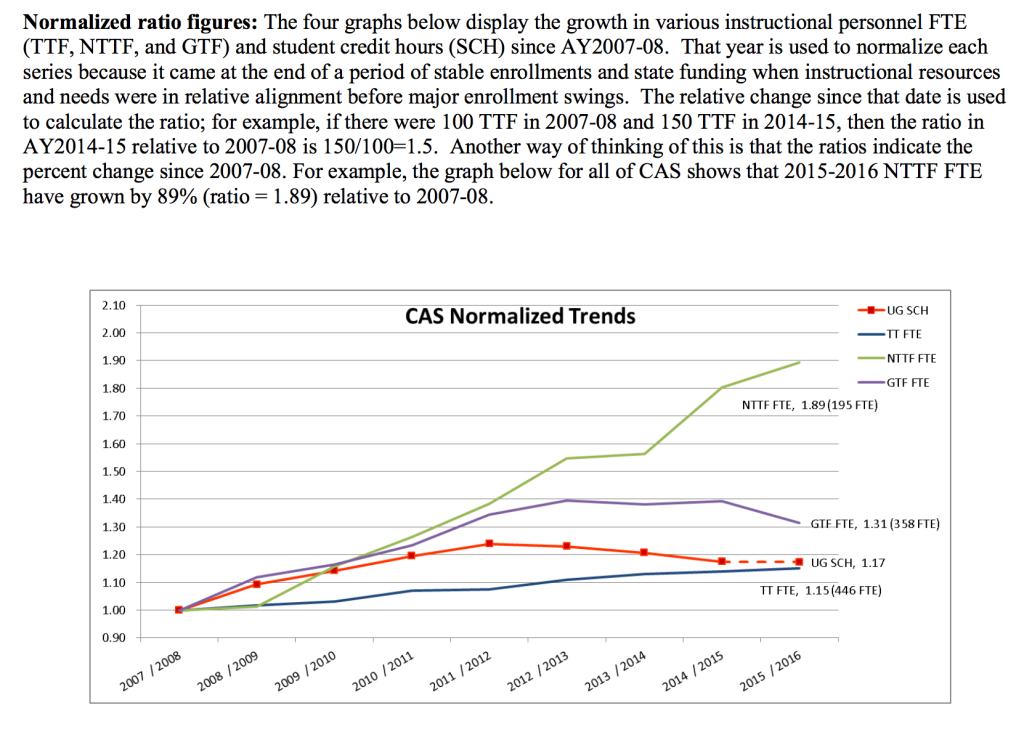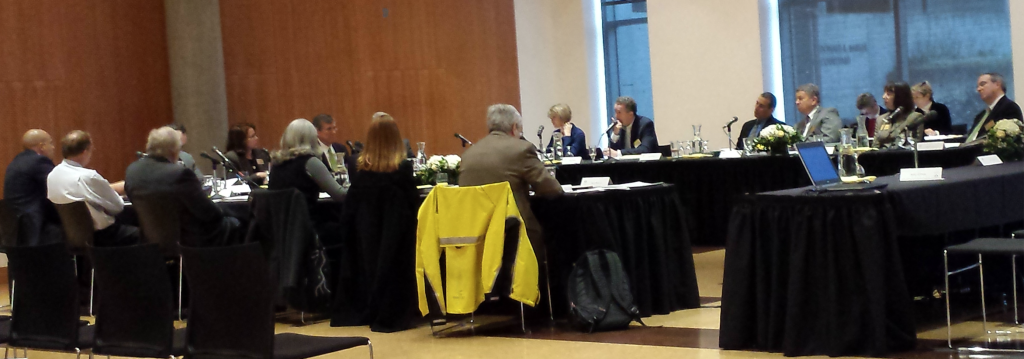Agenda here. Video should be posted here in a day or two. My battery died so live-blogging stopped after a little of the Q&A, sorry.
Cocktail party version of the 1/13/2015 Senate meeting:
President Schill and Provost Coltrane provided a clear justification for the realignment of resources towards what counts for the AAU and for research/teaching excellence. They outlined the plan and promised to implement their realignment proposals on the basis of data, and with plenty of consultation with the faculty, OA’s, and staff, in order to incorporate knowledge that’s not in the data.
Schill got many tough questions – though none about athletics money or the diversion of students from CAS humanities and some social-science fields into new professional school gen-ed courses and new undergrad programs in law, AAD etc. He gave straightforward answers. He promised more information than has ever been provided to the faculty before, both in terms of staffing numbers and budget data showing where the money has been going. I think he’s as curious as we are. We were told it would be posted on the IR website over the next few days and weeks.
Best of the Q&A: Schill: I’m not a robot, I don’t make all decisions by the numbers, I assume that’s why you wanted me. Or not. Professor: We want you.
As for Coltrane? It was as if he’d been released from a long, dark spell:
Now the hard part starts.
Senate Agenda, Library Browsing Room, Knight Library
3:00 pm Introductory Remarks, Senate President Randy Sullivan
3:05 pm 1. Call to Order
3:05 pm 2. Approval of Minutes
2.1 December 2, 2015
3:15 pm 4. New Business
4.1 IFS Election
Candidates: Robert Kyr (Music), Dejing Dou (Computer and Information Science)
The IFS meets regularly with the HECC. The IFS website is here: http://oregonstate.edu/senate/ifs/ifs.html
Kyr elected unanimously.
5.1 Topics: The President’s recent letter to the campus and the strategic plan.
President Schill’s letter to faculty here. Letter to admins below.
Schill: We’re asking donors and state and students to pay more, we have an obligation to do more and spend money wisely. Short run, need savings to get $4M for new tenure track faculty. Long run, need to redo Shelton’s budget model. We’ll do both, in consultation with colleges, departments, Senate.
Pitches centralization as way of saving money and increasing accountability, starting with Communications and IT.
Promises transparency. Work in progress – we’re telling you now, before plans are developed in detail, to prove it.
The message is not cuts. We’re going to growing and getting better, facing the future optimistically, investing in graduate education and undergraduate success. Not retrenchment – reallocation of resources, to ensure future eminence.
Letter to admins:
January 13, 2006
To: Scott Coltrane, Senior Vice President and Provost
Jamie Moffitt, Vice President for Finance & Administration & CFO
Mike Andreasen, Vice President for Advancement
Kyle Henley, Vice President for Communication
Yvette Alex-Assensoh, Vice President for Equity and Inclusion
Kevin Reed, Vice President and General Counsel
Brad Shelton, Interim Vice President for Research and Innovation
Roger Thompson, Vice President for Enrollment Management
Robin Holmes, Vice President for Student Life
From: Michael Schill, President
Re: Central Administrative Budget Cuts
Date: January 13, 2016
As you are aware from our conversations and my recent message to campus, it is imperative that we look for ways to better align our limited resources with the institution’s strategic priorities for academic excellence. To that end, we have dedicated significant recurring funding to tenure track faculty hires and the new clusters of excellence, as well as student retention and graduation initiatives. Additionally, while our budgets are tight, growing costs and investments in the area of labor agreements, health care costs, IT infrastructure, Title IX, and PERS are going to put additional pressure on our limited resources. For this reason, this spring I am launching a two-stage process to reduce our central administrative cost base.
The first step will involve a two percent direct cut on all general fund central administrative budgets, effective July 1, 2016 (FY2017). Given current administrative budget levels, I expect this cut to generate nearly $3 million of recurring funding that can be reinvested in institutional strategic priorities. I know and understand that our current staffing levels are lean and that it will be difficult to implement this cut. However, I expect each of you to look strategically in your portfolios and determine the best way to manage this budget reduction. I do not expect you to simply impose a two percent budget cut evenly across your units. Instead, I expect you to assess your operations for savings that will have the least impact on our core strategic objectives.
As we strategically align our general fund resources, it is critical that we pay attention to our students’ total cost of education. For this reason, it is important that we do not simply shift expenses to auxiliary funds. While this may be a less painful way in the short term to address the general fund cut, it will ultimately lead to higher fees and costs charged to our students.
In addition to implementing this two percent cut, I also expect vice presidents to actively manage their portfolio budgets to best align their resources with the institution’s strategic objectives: (1) building our academic and research profile, (2) keeping our university affordable to students and ensuring their success, and (3) creating a rich undergraduate experience in a diverse and inclusive community. I will be scheduling a series of review meetings the week of March 14 to discuss (1) your critical strategic initiatives for FY17, (2) how you have aligned resources to meet these goals, and (3) what steps you took to achieve the two percent budget savings in your portfolio.
In addition to the immediate, direct administrative budget cut, I also am launching an initiative to assess opportunities for longer term administrative cost savings based on targeted projects focused on centralization of services, strategic sourcing, and business process redesign. While these savings will take longer to capture, our goal will be to identify the equivalent of another three percent (roughly $4.5 million) of additional administrative cost savings over the next two to three years.
The budget office is currently updating BANNER budgets to account for changes related to the recent salary increase process, as well as updates to PEBB costs. Once these budgets are loaded, we will distribute updated general fund figures, as well as data regarding the exact size of the two percent budget cut for each Vice Presidential portfolio. If you have any questions about these figures, please contact Jamie Moffitt.
Provost Coltrane:
Introduces 5-year Strategic Plan, here. Explains that the CAS realignment followed below will be implemented in other colleges. Will get similar data for other colleges out soon. Will post these data on IR website. Preliminary, focus is on getting info out soon to identify problems, allow consultation.
There will also be a similar process for administrative departments. Budget model redesign will be led by Brad Shelton, with consultation with Senate.
Resources will be reallocated to make us a stronger research university. We will add money for 40 new fellowships, most for PhDs. Money will be available now, for this years recruiting of grad students for fall.
CAS example:
CAS Dean Andrew Marcus letter here.
Check full letter for breakout by CAS division.
No reduction in the total number of GTF lines, but there will be reallocations across departments.
Questions:
Margerum (AAA): Wondering how AAU metrics work for departments like his w/ no PhD students. Schill. Goal is excellence, we’re not a slave to metrics, but we’d like to increase # of PhD students. Different metrics for different departments – e.g. Law, MBA… . Coltrane: Our first focus is PhD’s though.
Clemmons (Business): Big revenue stream is CA undergrads. Is that changing? Schill: Yes, that is how we’ve subsidized Oregon students. Oregon students are key for us. But there’s a dip in Oregon HS students coming, might see some changes but no plans as of now. Demand for students is robust, in part because of athletics. [Serves up anecdote about admissions even at Alamo Bowl… Yes, if you recruit students at a bowl game, students will tell you that they care about the Ducks.]
Psaki (Romance Lang): Letter talked about poorly performing programs and excellence. What are the criteria for distinguishing this, and wouldn’t past resource allocation matter to what deptartments are now pocketed with excellence? Schill: That will be done by provost and the deans we are now hiring. That said I’d look at research productivity, teaching awards…. UO has done so much with so little … Psaki: yes. Schill: Only thing that would get me mad would be a department that thinks it’s “good enough”. Psaki: I know lots of UO humanities departs that are fabulous. I read – or tried to read – Coltrane’s Strategic Plan. Doesn’t seem like lots of room for humanities. How did it happen that these are not institutional priorities? Our “yield rates” are low because we have $13.5K fellowships while other schools have $23.5?
Schill: Maybe I should shut up, but I’m not a robot, don’t make all decisions by the numbers, I assume that’s why you wanted me. Come talk to me. Psaki: Yes, we want you.
[Sorry, battery dying, no more live blog.]
4:45 pm 6. Reports
4:45 pm 7. Notice(s) of Motion
4:45 pm 8. Other Business
5:00 pm 9. Adjournment
Realignment:
President Schill will be at the Senate meeting this Wednesday, 3-5PM in the Knight Library browsing room, to answer questions about the budget realignment letter he sent out Friday (post and comments here.) My takeaway is that the realignment is about keeping us in the AAU short-term, by shifting money towards research, more tenure-track faculty, and more grad student fellowships. Some pain will come with the gains.
Strategic Plan:
UO’s last plan was former Interim Provost Jim Bean’s 2009 Academic Plan – a yada-yada document that was so completely ignored nobody even noticed that it was never finalized. I don’t think our new leadership is going to let us down like that. They’ve been busy drafting plans to get UO back on track, and they’ve now started the process of presenting those plans to the university, getting feedback, and finalizing and implementing them.
Presumably Provost Coltrane will also be at this meeting, to answer questions about the 5-year Strategic Framework plan he developed in consultation with faculty, and released this afternoon. That’s longer run, and Coltrane is pretty clear that with current resource constraints much of it is aspirational. The website is here. The 11 page draft document is here:

